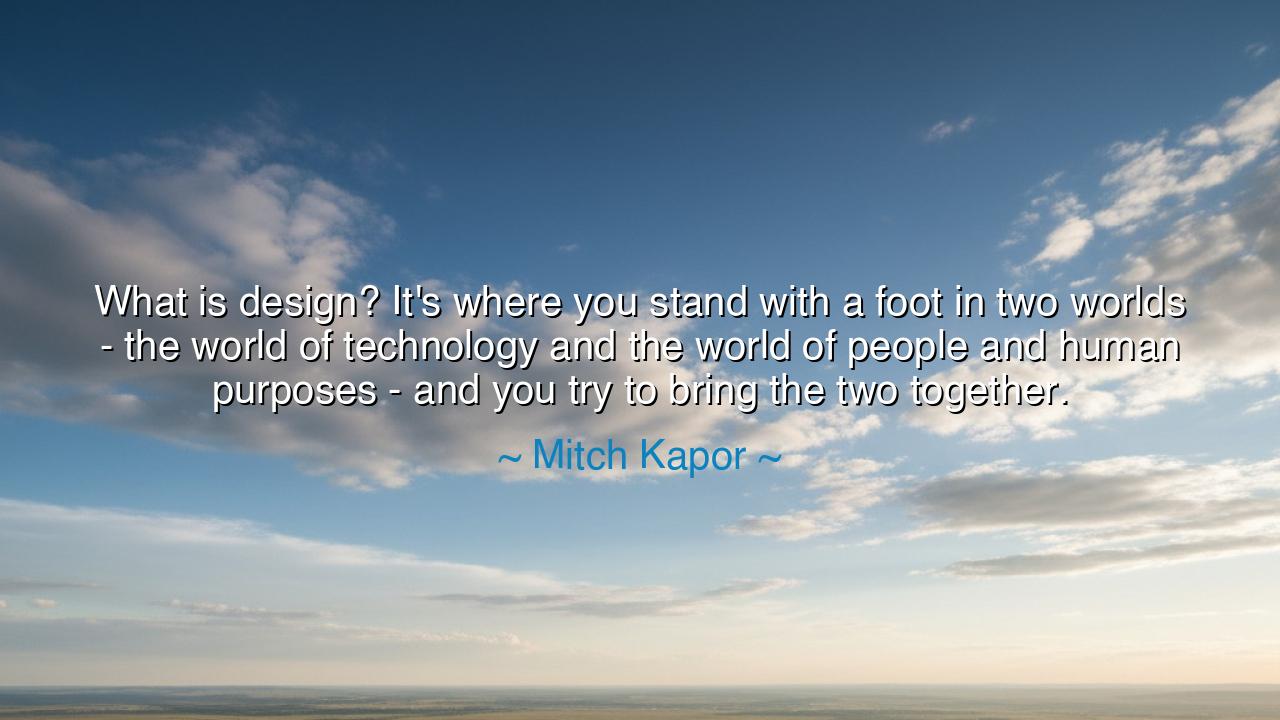
What is design? It's where you stand with a foot in two worlds -
What is design? It's where you stand with a foot in two worlds - the world of technology and the world of people and human purposes - and you try to bring the two together.






The visionary technologist Mitch Kapor, one of the early pioneers of personal computing, once defined the essence of his craft with these words: “What is design? It’s where you stand with a foot in two worlds — the world of technology and the world of people and human purposes — and you try to bring the two together.” In this statement lies not only a philosophy of design but a profound understanding of what it means to create in the modern age. For design, as Kapor reveals, is not merely the shaping of things, but the bridging of worlds — the delicate act of uniting the cold precision of machines with the warmth and complexity of human life.
To understand this quote, we must first remember the time and spirit from which it was born. Mitch Kapor, the creator of Lotus 1-2-3, lived at the dawn of the digital revolution, when computers were evolving from the mysterious tools of specialists into the companions of everyday people. He saw a challenge that few had yet grasped: technology alone could not transform the world unless it was made human — unless it served real needs, spoke in human language, and respected human emotion. The designer, he realized, must be a mediator between these two realms: standing with one foot in the world of circuits and code, and the other in the world of thought, feeling, and purpose. To design, then, is to act as both engineer and poet, shaping not just what works, but what matters.
This duality — this standing with a foot in two worlds — is the eternal challenge of the creator. In ancient times, it was the same for the builders of temples and cities. The Egyptian architect who raised the pyramids needed both mastery of geometry and reverence for the spirit. The Greeks, who perfected proportion, did not design for function alone, but for the soul — believing that harmony in structure reflected harmony in being. In every age, those who build must balance these two truths: that the tools of their craft are of the earth, but their purpose is of the heart. Design becomes, therefore, not just an act of creation, but a moral and spiritual pursuit — the art of joining what is mechanical with what is meaningful.
Consider the story of Steve Jobs, a man who, like Kapor, understood this sacred balance. When designing the first Macintosh, Jobs demanded not only technical brilliance but beauty. He famously said that design is not just how something looks, but how it works — and, deeper still, how it feels. The Macintosh was not merely a computer; it was a companion to creativity, a window through which human beings could express themselves. Jobs and his team stood, as Kapor described, with one foot in the logic of circuits and the other in the intuition of human experience. Their success was not in choosing one world over the other, but in bridging them — bringing technology into harmony with humanity.
Kapor’s words remind us that true design is not about domination, but reconciliation. The technologist who forgets the human spirit creates tools that enslave; the artist who ignores technology dreams without substance. But when both are joined — when logic meets empathy, when innovation serves meaning — something miraculous happens: we create things that empower, uplift, and transform. Every bridge, every piece of software, every crafted object that truly serves life is born from this sacred union. Thus, the designer is not merely a maker, but a translator — turning the language of technology into the poetry of usefulness.
And yet, this path is not easy. To stand with a foot in two worlds is to live in tension — to be pulled between precision and passion, between what can be done and what should be done. The designer must learn to listen deeply: to the voice of reason on one side, and the whisper of feeling on the other. One without the other leads to imbalance. The world has seen many inventions that dazzled with their cleverness but failed because they forgot the human heart. To design well, therefore, is to practice humility — to recognize that technology, no matter how advanced, must always bow to the needs of the soul.
Thus, my listener of the future, take these words of Mitch Kapor as both insight and instruction. Whatever you build — whether a machine, a system, or a life — remember to place one foot in the realm of skill, and the other in the realm of purpose. Let your creations be not only efficient but compassionate, not only intelligent but wise. Seek always to bridge, not to divide; to harmonize, not to dominate. For the true measure of design is not how perfectly it functions, but how deeply it serves the dignity of the human spirit.
In the end, the designer is a kind of philosopher — one who seeks unity between the mechanical and the moral, between creation and care. And in that balance lies the very secret of progress. So stand, as Kapor taught, with one foot in the world of technology and the other in the world of humanity — and let your work become the bridge between the two. For there, in that meeting of logic and love, lies not only good design, but the very art of living well.






AAdministratorAdministrator
Welcome, honored guests. Please leave a comment, we will respond soon